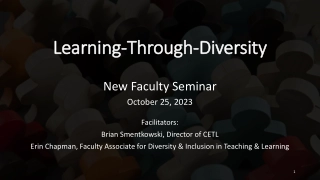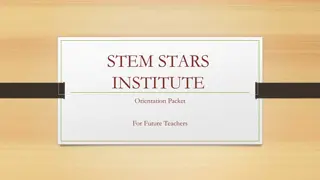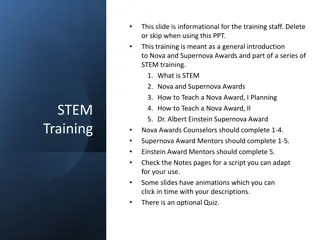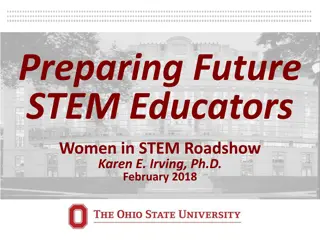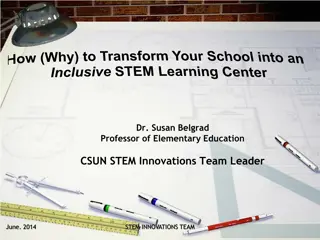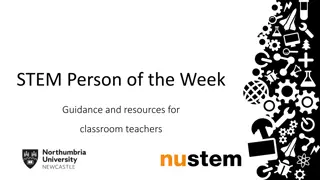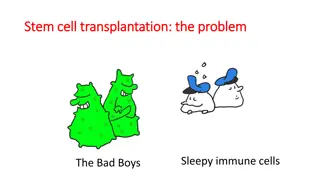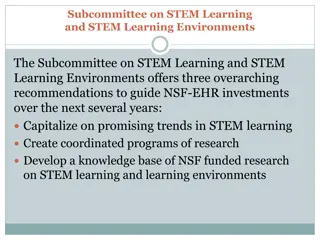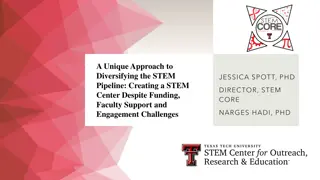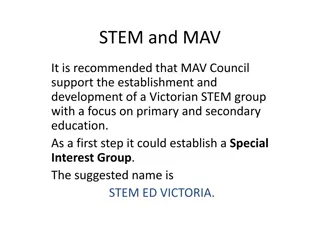Understanding Stem Cells and Their Potential Applications
Stem cells are undifferentiated cells with the unique ability to develop into various specialized cell types, making them valuable for medical applications. Dr. J. Gowri explores the classification, features, and properties of stem cells, shedding light on their self-renewal and potency. These cells hold great promise for regenerative medicine and research into treating various diseases.
Download Presentation

Please find below an Image/Link to download the presentation.
The content on the website is provided AS IS for your information and personal use only. It may not be sold, licensed, or shared on other websites without obtaining consent from the author. Download presentation by click this link. If you encounter any issues during the download, it is possible that the publisher has removed the file from their server.
E N D
Presentation Transcript
Stem Cells & Their Applications preSENTED preSENTED BY BY Dr. j. Dr. j. gowri gowri assistant professor assistant professor DEPT OF BIOTECHNOLOGY DEPT OF BIOTECHNOLOGY 1
Stem cells Stem cells are undifferentiated biological cells that can differentiate into specialized cells or can divide to produce more stem cells. They are found in multicellular organisms. In mammals, there are two broad types of stem cells: embryonic stem cells, which are isolated from the inner cell mass of blastocysts, and adult stem cells, which are found in various tissues. In a developing embryo, stem cells can differentiate into all the specialized cells ectoderm, endoderm and mesoderm. Stem Cells Presenter : Dr. J. Gowri 2
Features of Stem Cells 1. Stem Cells are very unique cells. 2. Stem Cells have the amazing ability to develop into several distinct cell types in the body. 3. Stem Cells can be used as a repair system for the body. 4. Stem Cells can divide without limit in a living organism in order to replenish various types of cells. 5. When a stem cell divides, each new cell has the potential to either remain a stem cell or become another type of cell with a more specialized function (i.e. a muscle cell, a red blood cell, a brain cell, etc.). Stem Cells 3 Presenter : Dr. J. Gowri
Classification based on origin stem cells from embryos, stem cells from fetus, stem cells from the umbilical cord, stem cells from the adult. Stem Cells 4 Presenter : Dr. J. Gowri
Properties Self-renewal: the ability to go through numerous cycles of cell division while maintaining the undifferentiated state. Potency: the capacity to differentiate into specialized cell types. Stem Cells 5 Presenter : Dr. J. Gowri
Self renewal Self-renewal is the process by which stem cells divide to make more stem cells. Self-renewal is division with maintenance of the undifferentiated state. Each stem cell has the potential to remain as a stem cell or to differentiate to a another type of cell through differentiation. Stem Cells 6 Presenter : Dr. J. Gowri
Potency Potency specifies the differentiation potential (the potential to differentiate into different cell types) of the stem cell. Potency is classified as: Totipotent Pluripotent Multipotent Unipotent Stem Cells 7 Presenter : Dr. J. Gowri
Types of potency Totipotent stem cells are found only in early embryos. Each cell can form a complete organism (1-3 days- Morulla). Pluripotent stem cells exist in the undifferentiated inner cell mass of the blastocyst (5 to 14 days) and can form any of the over 200 different cell types found in the body. Stem cells can form most or all cell types in the adult Multipotent stem cells are derived from fetal tissue, cord blood, and adult stem cells. These cells are differentiated, but can form a number of other tissues. Stem cells can form multiple types of cells and tissue types. Unipotent able to contribute to only one mature cell type but have the property of self-renewal which distinguishes them from non-stem cells. Stem Cells 8 Presenter : Dr. J. Gowri
Embryonic stem cells Embryonic stem cells are derived from a four- or five-day-old human embryo that is in the blastocyst phase of development. They have the ability to form virtually any type of cell found in the human body. ES cells are pluripotent and give rise during development to all derivatives of the three primary germ layers: Ectoderm Endoderm Mesoderm. They can develop into each of the more than 200 cell types of the adult body . They do not contribute to the extra-embryonic membranes or the placenta. Stem Cells 9 Presenter : Dr. J. Gowri
Stages of Embryogenesis Embryonic stem cells Day 2 2-cell embryo Day 3-4 Day 1 Multi-cell embryo Fertilized egg Day 5-6 Blastocyst Day 11-14 Tissue Differentiation
Sources of embryonic type stem cells Embryos - Embryonic stem cells are obtained by harvesting living embryos which are generally 5-7 days old. The removal of embryonic stem cells invariably results in the destruction of the embryo. Fetuses - Another kind of stem cell, called an embryonic germ cell, can be obtained from either miscarriages or aborted fetuses. Stem Cells 11 Presenter : Dr. J. Gowri
Isolation The majority of ESC lines are mouse, not human. The basic protocol for generation of ESCs is similar for all species. ESCs are pluripotent stem cells generated from early-stage embryos. Cells are harvested from the blastocyst 4 5 days post-fertilization. The outer cell layer of the blastocyst, called the trophoblast, contains a fluid-filled cavity, the blastocoele, and an inner cell mass of 10 20 cells. The inner cell mass, which is also called the embryoblast, is removed for culture. The cells from the inner mass are placed in culture, and those that are viable are expanded. Stem Cells 12 Presenter : Dr. J. Gowri
Adult stem cells Adult stem cells have been found in the brain, bone marrow, blood vessels, skeletal muscle, skin, teeth, heart, gut, liver, and other organs and tissues. Adult stem cells can be isolated from the body in different ways, depending on the tissue. Blood stem cells, for example, can be taken from a donor s bone marrow, from blood in the umbilical cord when a baby is born, or from a person s circulating blood. Mesenchymal stem cells, which can make bone, cartilage, fat, fibrous connective tissue. Neural stem cells (which form the brain s three major cell types) have been isolated from the brain and spinal cord. Stem Cells 13 Presenter : Dr. J. Gowri
Isolation From the body From amniotic fluid From other adult stem cells Stem Cells 14 Presenter : Dr. J. Gowri
Culturing of Stem cells The culture conditions and types of media used for stem cell culture depend on the type of stem cell. There are a wide range of protocols and products available for both maintaining stem cells in an undifferentiated state and for differentiating them into different lineages and cell types Stem Cells 15 Presenter : Dr. J. Gowri
Feeder cell layers All the ESC cultures are maintained on feeder cell layers. Inactivated mouse embryonic fibroblasts (MEFs) were used as feeder layers that provide factors and a substrate that allow ESCs to grow and divide. There are several problems associated with MEFs, including the potential for the introduction of mouse-derived infectious agents, undesirable protein transfer Stem Cells 16 Presenter : Dr. J. Gowri
Methodology MEFs can either be purchased or freshly generated in the lab. Fibroblasts from ~14 15-day-old fetal mice are cultured and expanded for 3 4 days. To be used as a feeder layer, MEFs must be mitotically inactivated, either by irradiation with UV light or incubation with mitomycin C. Stocks of MEF cells can be frozen either before or after inactivation Stem Cells 17 Presenter : Dr. J. Gowri
How Does Cell Therapy Work? Stem cells can be used to generate healthy and functioning specialized cells, which can then replace diseased or dysfunctional cells. It is similar to the process of organ transplantation only the treatment consists of transplanting cells instead of organs. More than 80 disease can be cured using stem cell therapy- Alzheimer s disease Parkinson s disease Spinal cord injury Heart disease Severe burns Diabetes Stem Cells 18 Presenter : Dr. J. Gowri
THANK YOU 19



